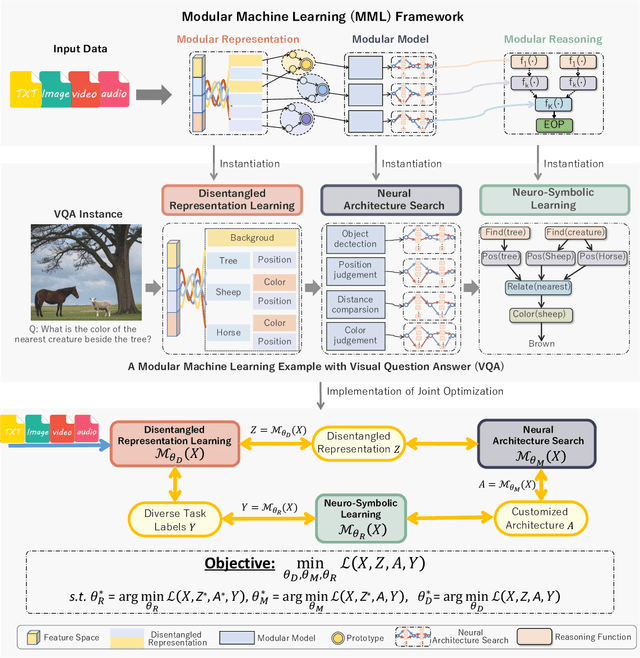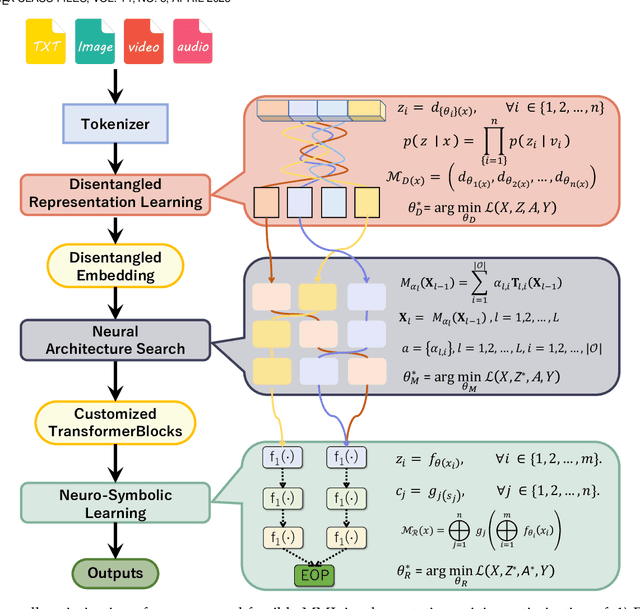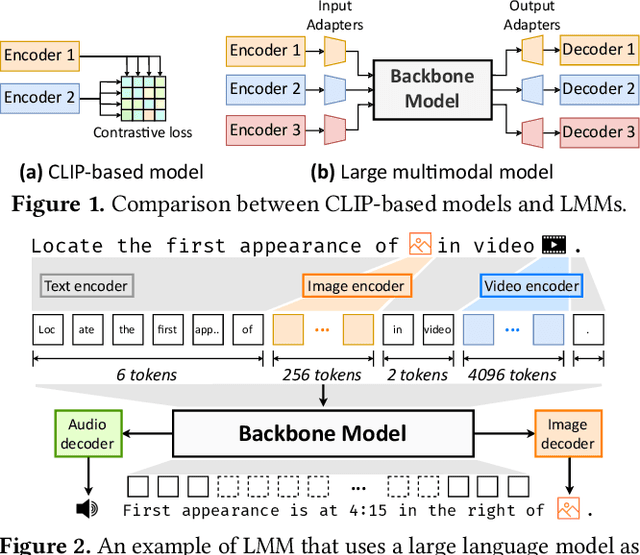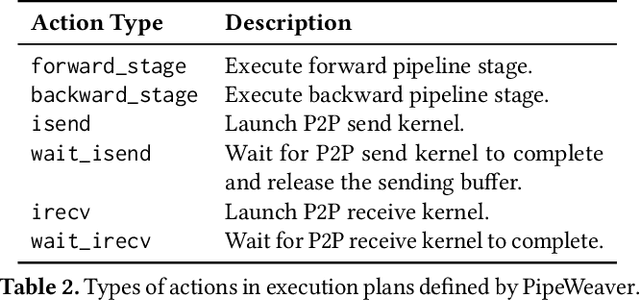Haibo Chen
FairBatching: Fairness-Aware Batch Formation for LLM Inference
Oct 16, 2025Abstract:Large language model (LLM) inference systems face a fundamental tension between minimizing Time-to-First-Token (TTFT) latency for new requests and maintaining a high, steady token generation rate (low Time-Per-Output-Token, or TPOT) for ongoing requests. Existing stall-free batching schedulers proposed by Sarathi, while effective at preventing decode stalls, introduce significant computational unfairness. They prioritize decode tasks excessively, simultaneously leading to underutilized decode slack and unnecessary prefill queuing delays, which collectively degrade the system's overall quality of service (QoS). This work identifies the root cause of this unfairness: the non-monotonic nature of Time-Between-Tokens (TBT) as a scheduling metric and the rigid decode-prioritizing policy that fails to adapt to dynamic workload bursts. We therefore propose FairBatching, a novel LLM inference scheduler that enforces fair resource allocation between prefill and decode tasks. It features an adaptive batch capacity determination mechanism, which dynamically adjusts the computational budget to improve the GPU utilization without triggering SLO violations. Its fair and dynamic batch formation algorithm breaks away from the decode-prioritizing paradigm, allowing computation resources to be reclaimed from bursting decode tasks to serve prefill surges, achieving global fairness. Furthermore, FairBatching provides a novel load estimation method, enabling more effective coordination with upper-level schedulers. Implemented and evaluated on realistic traces, FairBatching significantly reduces TTFT tail latency by up to 2.29x while robustly maintaining TPOT SLOs, achieving overall 20.0% improvement in single-node capacity and 54.3% improvement in cluster-level capacity.
A Case for Declarative LLM-friendly Interfaces for Improved Efficiency of Computer-Use Agents
Oct 06, 2025Abstract:Computer-use agents (CUAs) powered by large language models (LLMs) have emerged as a promising approach to automating computer tasks, yet they struggle with graphical user interfaces (GUIs). GUIs, designed for humans, force LLMs to decompose high-level goals into lengthy, error-prone sequences of fine-grained actions, resulting in low success rates and an excessive number of LLM calls. We propose Goal-Oriented Interface (GOI), a novel abstraction that transforms existing GUIs into three declarative primitives: access, state, and observation, which are better suited for LLMs. Our key idea is policy-mechanism separation: LLMs focus on high-level semantic planning (policy) while GOI handles low-level navigation and interaction (mechanism). GOI does not require modifying the application source code or relying on application programming interfaces (APIs). We evaluate GOI with Microsoft Office Suite (Word, PowerPoint, Excel) on Windows. Compared to a leading GUI-based agent baseline, GOI improves task success rates by 67% and reduces interaction steps by 43.5%. Notably, GOI completes over 61% of successful tasks with a single LLM call.
SmallThinker: A Family of Efficient Large Language Models Natively Trained for Local Deployment
Jul 28, 2025Abstract:While frontier large language models (LLMs) continue to push capability boundaries, their deployment remains confined to GPU-powered cloud infrastructure. We challenge this paradigm with SmallThinker, a family of LLMs natively designed - not adapted - for the unique constraints of local devices: weak computational power, limited memory, and slow storage. Unlike traditional approaches that mainly compress existing models built for clouds, we architect SmallThinker from the ground up to thrive within these limitations. Our innovation lies in a deployment-aware architecture that transforms constraints into design principles. First, We introduce a two-level sparse structure combining fine-grained Mixture-of-Experts (MoE) with sparse feed-forward networks, drastically reducing computational demands without sacrificing model capacity. Second, to conquer the I/O bottleneck of slow storage, we design a pre-attention router that enables our co-designed inference engine to prefetch expert parameters from storage while computing attention, effectively hiding storage latency that would otherwise cripple on-device inference. Third, for memory efficiency, we utilize NoPE-RoPE hybrid sparse attention mechanism to slash KV cache requirements. We release SmallThinker-4B-A0.6B and SmallThinker-21B-A3B, which achieve state-of-the-art performance scores and even outperform larger LLMs. Remarkably, our co-designed system mostly eliminates the need for expensive GPU hardware: with Q4_0 quantization, both models exceed 20 tokens/s on ordinary consumer CPUs, while consuming only 1GB and 8GB of memory respectively. SmallThinker is publicly available at hf.co/PowerInfer/SmallThinker-4BA0.6B-Instruct and hf.co/PowerInfer/SmallThinker-21BA3B-Instruct.
An AI-native experimental laboratory for autonomous biomolecular engineering
Jul 03, 2025Abstract:Autonomous scientific research, capable of independently conducting complex experiments and serving non-specialists, represents a long-held aspiration. Achieving it requires a fundamental paradigm shift driven by artificial intelligence (AI). While autonomous experimental systems are emerging, they remain confined to areas featuring singular objectives and well-defined, simple experimental workflows, such as chemical synthesis and catalysis. We present an AI-native autonomous laboratory, targeting highly complex scientific experiments for applications like autonomous biomolecular engineering. This system autonomously manages instrumentation, formulates experiment-specific procedures and optimization heuristics, and concurrently serves multiple user requests. Founded on a co-design philosophy of models, experiments, and instruments, the platform supports the co-evolution of AI models and the automation system. This establishes an end-to-end, multi-user autonomous laboratory that handles complex, multi-objective experiments across diverse instrumentation. Our autonomous laboratory supports fundamental nucleic acid functions-including synthesis, transcription, amplification, and sequencing. It also enables applications in fields such as disease diagnostics, drug development, and information storage. Without human intervention, it autonomously optimizes experimental performance to match state-of-the-art results achieved by human scientists. In multi-user scenarios, the platform significantly improves instrument utilization and experimental efficiency. This platform paves the way for advanced biomaterials research to overcome dependencies on experts and resource barriers, establishing a blueprint for science-as-a-service at scale.
Towards Multi-modal Graph Large Language Model
Jun 11, 2025Abstract:Multi-modal graphs, which integrate diverse multi-modal features and relations, are ubiquitous in real-world applications. However, existing multi-modal graph learning methods are typically trained from scratch for specific graph data and tasks, failing to generalize across various multi-modal graph data and tasks. To bridge this gap, we explore the potential of Multi-modal Graph Large Language Models (MG-LLM) to unify and generalize across diverse multi-modal graph data and tasks. We propose a unified framework of multi-modal graph data, task, and model, discovering the inherent multi-granularity and multi-scale characteristics in multi-modal graphs. Specifically, we present five key desired characteristics for MG-LLM: 1) unified space for multi-modal structures and attributes, 2) capability of handling diverse multi-modal graph tasks, 3) multi-modal graph in-context learning, 4) multi-modal graph interaction with natural language, and 5) multi-modal graph reasoning. We then elaborate on the key challenges, review related works, and highlight promising future research directions towards realizing these ambitious characteristics. Finally, we summarize existing multi-modal graph datasets pertinent for model training. We believe this paper can contribute to the ongoing advancement of the research towards MG-LLM for generalization across multi-modal graph data and tasks.
Get Experience from Practice: LLM Agents with Record & Replay
May 23, 2025Abstract:AI agents, empowered by Large Language Models (LLMs) and communication protocols such as MCP and A2A, have rapidly evolved from simple chatbots to autonomous entities capable of executing complex, multi-step tasks, demonstrating great potential. However, the LLMs' inherent uncertainty and heavy computational resource requirements pose four significant challenges to the development of safe and efficient agents: reliability, privacy, cost and performance. Existing approaches, like model alignment, workflow constraints and on-device model deployment, can partially alleviate some issues but often with limitations, failing to fundamentally resolve these challenges. This paper proposes a new paradigm called AgentRR (Agent Record & Replay), which introduces the classical record-and-replay mechanism into AI agent frameworks. The core idea is to: 1. Record an agent's interaction trace with its environment and internal decision process during task execution, 2. Summarize this trace into a structured "experience" encapsulating the workflow and constraints, and 3. Replay these experiences in subsequent similar tasks to guide the agent's behavior. We detail a multi-level experience abstraction method and a check function mechanism in AgentRR: the former balances experience specificity and generality, while the latter serves as a trust anchor to ensure completeness and safety during replay. In addition, we explore multiple application modes of AgentRR, including user-recorded task demonstration, large-small model collaboration and privacy-aware agent execution, and envision an experience repository for sharing and reusing knowledge to further reduce deployment cost.
Modular Machine Learning: An Indispensable Path towards New-Generation Large Language Models
Apr 28, 2025


Abstract:Large language models (LLMs) have dramatically advanced machine learning research including natural language processing, computer vision, data mining, etc., yet they still exhibit critical limitations in reasoning, factual consistency, and interpretability. In this paper, we introduce a novel learning paradigm -- Modular Machine Learning (MML) -- as an essential approach toward new-generation LLMs. MML decomposes the complex structure of LLMs into three interdependent components: modular representation, modular model, and modular reasoning, aiming to enhance LLMs' capability of counterfactual reasoning, mitigating hallucinations, as well as promoting fairness, safety, and transparency. Specifically, the proposed MML paradigm can: i) clarify the internal working mechanism of LLMs through the disentanglement of semantic components; ii) allow for flexible and task-adaptive model design; iii) enable interpretable and logic-driven decision-making process. We present a feasible implementation of MML-based LLMs via leveraging advanced techniques such as disentangled representation learning, neural architecture search and neuro-symbolic learning. We critically identify key challenges, such as the integration of continuous neural and discrete symbolic processes, joint optimization, and computational scalability, present promising future research directions that deserve further exploration. Ultimately, the integration of the MML paradigm with LLMs has the potential to bridge the gap between statistical (deep) learning and formal (logical) reasoning, thereby paving the way for robust, adaptable, and trustworthy AI systems across a wide range of real-world applications.
L3: DIMM-PIM Integrated Architecture and Coordination for Scalable Long-Context LLM Inference
Apr 24, 2025Abstract:Large Language Models (LLMs) increasingly require processing long text sequences, but GPU memory limitations force difficult trade-offs between memory capacity and bandwidth. While HBM-based acceleration offers high bandwidth, its capacity remains constrained. Offloading data to host-side DIMMs improves capacity but introduces costly data swapping overhead. We identify that the critical memory bottleneck lies in the decoding phase of multi-head attention (MHA) exclusively, which demands substantial capacity for storing KV caches and high bandwidth for attention computation. Our key insight reveals this operation uniquely aligns with modern DIMM-based processing-in-memory (PIM) architectures, which offers scalability of both capacity and bandwidth. Based on this observation and insight, we propose L3, a hardware-software co-designed system integrating DIMM-PIM and GPU devices. L3 introduces three innovations: First, hardware redesigns resolve data layout mismatches and computational element mismatches in DIMM-PIM, enhancing LLM inference utilization. Second, communication optimization enables hiding the data transfer overhead with the computation. Third, an adaptive scheduler coordinates GPU-DIMM-PIM operations to maximize parallelism between devices. Evaluations using real-world traces show L3 achieves up to 6.1$\times$ speedup over state-of-the-art HBM-PIM solutions while significantly improving batch sizes.
PipeWeaver: Addressing Data Dynamicity in Large Multimodal Model Training with Dynamic Interleaved Pipeline
Apr 19, 2025



Abstract:Large multimodal models (LMMs) have demonstrated excellent capabilities in both understanding and generation tasks with various modalities. While these models can accept flexible combinations of input data, their training efficiency suffers from two major issues: pipeline stage imbalance caused by heterogeneous model architectures, and training data dynamicity stemming from the diversity of multimodal data. In this paper, we present PipeWeaver, a dynamic pipeline scheduling framework designed for LMM training. The core of PipeWeaver is dynamic interleaved pipeline, which searches for pipeline schedules dynamically tailored to current training batches. PipeWeaver addresses issues of LMM training with two techniques: adaptive modality-aware partitioning and efficient pipeline schedule search within a hierarchical schedule space. Meanwhile, PipeWeaver utilizes SEMU (Step Emulator), a training simulator for multimodal models, for accurate performance estimations, accelerated by spatial-temporal subgraph reuse to improve search efficiency. Experiments show that PipeWeaver can enhance LMM training efficiency by up to 97.3% compared to state-of-the-art systems, and demonstrate excellent adaptivity to LMM training's data dynamicity.
AttentionEngine: A Versatile Framework for Efficient Attention Mechanisms on Diverse Hardware Platforms
Feb 21, 2025Abstract:Transformers and large language models (LLMs) have revolutionized machine learning, with attention mechanisms at the core of their success. As the landscape of attention variants expands, so too do the challenges of optimizing their performance, particularly across different hardware platforms. Current optimization strategies are often narrowly focused, requiring extensive manual intervention to accommodate changes in model configurations or hardware environments. In this paper, we introduce AttentionEngine, a comprehensive framework designed to streamline the optimization of attention mechanisms across heterogeneous hardware backends. By decomposing attention computation into modular operations with customizable components, AttentionEngine enables flexible adaptation to diverse algorithmic requirements. The framework further automates kernel optimization through a combination of programmable templates and a robust cross-platform scheduling strategy. Empirical results reveal performance gains of up to 10x on configurations beyond the reach of existing methods. AttentionEngine offers a scalable, efficient foundation for developing and deploying attention mechanisms with minimal manual tuning. Our code has been open-sourced and is available at https://github.com/microsoft/AttentionEngine.
 Add to Chrome
Add to Chrome Add to Firefox
Add to Firefox Add to Edge
Add to Edge